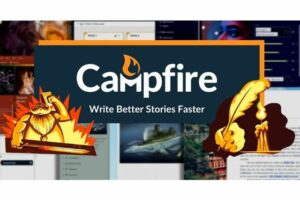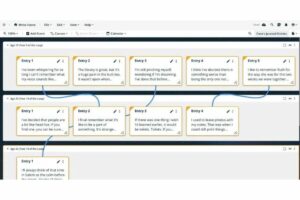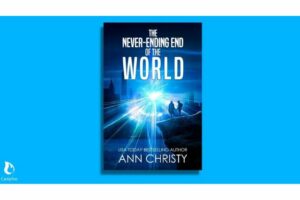
Writing isn’t a one-size-fits-all sort of job. Everyone does it differently and that’s a good thing. It’s how the creativity engine keeps running, and how we get to read truly great books on a regular basis.
But when we talk about how these great stories are created, the old trope of “two kinds of people” gets rolled out. Some authors are plotters, some are pantsers. And some writers are plantsers, those who combine the worlds of pantsers and plotters into something uniquely theirs.
No matter which we are, though, writers also need the right tools to work through this story creation process. There are several great tools for plotters out there, from the Hero’s Journey storytelling method to books that break down impactful modern bestsellers to software dedicated wholly to doing the thing. But can these work for the rest of us? The pantsers and plantsers? For us, there is a critical need for tools that will help us organize our writing without destroying the creative spark.
Let’s take a look at plotting, pantsing, and plantsing, and see how a writing and worldbuilding tool like Campfire can be useful, regardless of our individual and unique plotting styles.
What Does It Mean to be a Plotter, Pantser, or Plantser?
- Plotters can be roughly defined as a writer who gets an idea and then lays that idea out, getting their arcs and plots and subplots in order and in the right place before writing.
- Pantsing can be roughly defined as when a writer who gets an idea and writes the story as it comes to them. They fill out the germ of their idea as they go.
- Plantsers are harder to define because very few plantsers do things the same way, but they utilize both methods.
Like I said, those are rough definitions and that’s because there is a wide spectrum between those two end caps and a good many writers fall somewhere in between as plantsers.
Pantsing and Plantsing: The Stigma of Not Being a Plotter
Plotter or pantser: which are you? This used to be a naughty question and one I have personally witnessed authors lie about with a totally straight face. Being a pantser used to cause raised eyebrows, while plotters were thought of as the “have-it-all-together” writers who could create actual literature.
Bah. None of that is even remotely true. Pantsing is as entirely legitimate as plotting. Great work can and does come from both types of writers. I’m a pantser who changed herself into a plantser… Meaning I run with ideas, but create my plots and arcs using methods other than outlines or other traditional plotting strategies.
More than once I’ve talked to writers that are natural pantsers (and very good at it) who tried traditional tools to help them become plotters. I have also later heard how following a strict plotting regime destroyed their love of that book. On one occasion, I also had the delightful experience of listening to a natural plotter talk about the mess they made when they tried to pants a book.
I’m not making digs, just illustrating a point: we are all different. Some writers will be natural pantsers and some will be plotters, with a liberal portion falling somewhere in between the extremes to cluster around the middle where we plantsers make camp.
Pantser to Plantser: Using Campfire to Plot My Books

But I’m an avid Campfire user! I can’t possibly be a pantser, right? With its themed writing and worldbuilding modules, Campfire is for the organized ones who know the villain will die on page 347 before they even write the first sentence, right? Again, I say bah to that notion. No matter which of the “P” words you identify with, a writer still needs tools…
Campfire can help you make the most of your place on the plotting spectrum. As a pantser-turned-plantser, I speak from personal experience when I say that having the right tool for you will absolutely help you become a much better writer.
Iterating on Classic Plotting Methods
I’ve used Campfire since it was a standalone program without most of the modules that now exist. Because it’s easy to use and very, very visual, it lets me see where I need to go without bogging myself down with words that aren’t in my manuscript. I can keep my writing thoughts for the work.
Your process might look a little different, though:
- Some plantsers keep special notebooks ready for ideas when they strike to draw pictures, bubbles with arrows leading from place to place, or lists of things they must remember to put into the manuscript as they go.
- Others draw on whiteboards, which I used pre-Campfire.
- Still others use endless sticky notes, color coded by topic, carrying a few words or reminders.
If you’re a pantser looking to shift to plantsing for the sake of your sanity, then this is where you should focus. Notice the similarities in all these approaches. All of them are brief, visual, and don’t require you to stop the flow of your writing to create them. That is often the key point writing tools miss.
Pantsers do need help so they don’t wind up ditching whole plotlines or chapters because they missed some key element while pantsing, but they have to stay in the zone while using that help. Each of these methods allows for that flow.
But how can you replicate these traditional methods in your writing software?
Writing The Never-Ending End of the World

Like a lot of natural pantsers, my creativity engine is inconveniently loud. I’ll give you a prime example. I got the idea for my book The Never-Ending End of the World while I was brushing my teeth before bed. Not the whole book itself, but a character, Coco. I had this weird flash of a young woman in a crowded city that was suspiciously still and bright, telling me she’d been whispering so long she didn’t remember what her voice sounded like.
I thought, Okay, that was odd. Then I went to bed. When I woke, the book was in my head. The journeys, the challenges, the growth, the people, the basics of the physics…all of it. As a natural pantser, my inclination would be to immediately sit down and write the book without a second thought. This is where plantsing comes in, and where writing tools make their vital appearance.
As I began with the book fresh in my mind, I also began to populate my Campfire modules. I filled in my Character elements, set up arcs, and populated the Timeline Module—all of it. When I took a break to make more coffee, because yeah, caffeine, I created a playlist of songs that represented the significant plot points. This is my version of writing out the plot while capturing what the emotional context for those plot points should be.
If this sounds like a chaotic and unduplicable process to you, then look closer. As a pantser, I need to capture the moment when I’m flush and full of the idea. This is a common and, frankly, beautiful part of being a pantser. If I get down into the secretarial weeds, I might lose that moment and recapturing it might be impossible. So, my tools are a part of the flow, not an interruption of it. They are used while I’m writing, not before it.
Improving an Imperfect Process
I must admit, however, that my Campfire modules can get messy. The plotting process is still a mutable thing. Usually, when I take a break because my brain is fried and my back hurts from ten hours of frantic key tapping, I grab the laptop and start cleaning up my modules.
Because I input everything while writing, it’s all very fresh and spontaneous, allowing me to get into that headspace while I move around character cards or fill in a few arc cards. Almost always, this process reminds me of things I need to include in the book I’m working on, so I add those cards and highlight them for my next round at the computer. It’s almost like… gasp… plotting!
Campfire allows me to easily move between screens to quickly drag a card, or a picture, or a timeline, and type a few words telling me what that card is for. It’s fast and an integral part of the process, rather than something I have to stop writing to do.
This has allowed me to become a far more focused writer without destroying my creative engine. Finding the right tool allowed me to improve upon and refine my personal plotting style. Now, I cut far fewer parts out of my books and run down far fewer rabbit holes. Seriously, it’s made everything easier.
Embrace Your Plotting Style
If you’re a pantser or a plantser, I encourage you to embrace that, even as you try to find ways to harness it into greater usefulness. Don’t force yourself to use checklists and binders if it doesn’t feel right to do so.
Grab onto the visual tools that enhance your creativity engine while preserving your ideas and your sanity. Sure, you could read the books about plotting and watch endless YouTube how-to videos, but don’t pigeonhole yourself with the notion that plotting is the only way to be a “real” writer. Instead, explore and you’ll find what works for you.

Ann Christy is a retired Navy Commander with an educational and professional background in oceanographic and meteorological physics, biochemical marine science, and coastal ecosystems. She also sometimes writes books and is a USA Today and Wall Street Journal Bestselling author! Releasing in August 2023 with Campfire Publishing, her latest sci-fi epic, The Never-Ending End of the World, follows a woman who wakes up to a world frozen in time. For a limited time, The Never-Ending End of the World e-book is on sale for $0.99.

